Unit - 4
Definition of Network Function
A) One port Network:
The one port network can be represented as shown below. It has only one port i.e. input port or only output port.
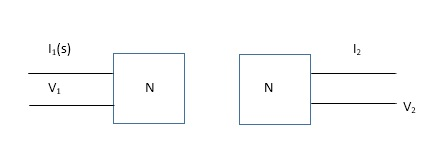
Fig 1) one port networks
1) Driving point impedance at input port
Z11(S) = V1(S) / I1(S)
2) Driving point impedance at output port
Z22(S) = V2(S) / I2(S)
3) Driving point admittance at input port
Y11(S) = I2(S) / V2(S)
4) Driving point admittance at output port
Y22(S) = I2(S) / V2(S)
After studying above equations, it can be clearly that
Z11(S) = 1 / Y11(S) And Z22(S)=1/Y22(S)
B) Two Port Network:
The network as the name says has two one input and other output port.

Fig 2) Two port network
1)Transfer Function impedance Z11(S) = V2(S) / I1(S)
2) Transfer admittance function Y12(S) = I2(S) / V1(S)
Key takeaway
Driving point impedance at input port
Z11(S) = V1(S) / I1(S)
Transfer Function impedance for two port networks
Z11(S) = V2(S) / I1(S)
Transfer admittance function Y12(S) = I2(S) / V1(S)
Current ratio transfer function Y12(S) = I2(S) / I1(S)
Voltage ration transfer function G12(S) / V2(S) / V1(S)
The driving point impedance is given for a two port network as
v1 = Z11I1 + Z12I2
v2 = Z11I1 + Z22I2
 =
= 
Z11 =  I2=0
I2=0
Z12 =  I1=0
I1=0
Z21 =  I2=0
I2=0
Z22 =  I1=0
I1=0
 I1 and I2 are excitations at port 1 & 2 respectively.
I1 and I2 are excitations at port 1 & 2 respectively.
 V1 and V2 are the responses at port 1 and 2 respectively.
V1 and V2 are the responses at port 1 and 2 respectively.
The driving point admittance for two port network function will be
I1 = Y11V1 + Y12V2
I2 = Y21V1 + Y22V2

Y11 =  V2=0
V2=0
Y12 =  V1=0
V1=0
Y21 =  V2=0
V2=0
Y22 =  V1=0
V1=0
V1& V2 should be independent
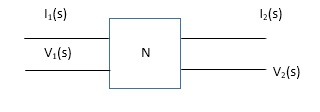
The value of current and voltage transfer function ratio for a two port network is given as
Current ratio transfer function Y12(S) = I2(S) / I1(S)
Voltage ration transfer function G12(S) / V2(S) / V1(S)
Restrictions of poles and zeros on driving point function
N(s) =p(s) =qosn+q,sn--------an/ q(s) bosn+b,sn-----------bn
1) All coefficient of p(s) and q(s) should be real and positive
2) poles and zeros must be conjugal whether imaginary or complex
3) Real part of poles and zeros must be negative or zero.
4) The degree of p(s) may differ either by zero or 1.
5) Lowest degree of p(s) and q(s) may differ at the most by one.
6) p(s) and q(s) cannot missing terms between highest and lowest degree unless all when or all odd terms are missing.
Q) Find whether the following network function represent the driving point function.
a) f(s)= (s+1)/(s2+1) b) f(s) = 3s2+2s+1/ss3+9s2+3s+2 c) f(s)=(s2+1)2/s2(s+3)
Solution
a) f(s)=s+1/s2+1
It represents the driving point function:
b) F(s)=3s2+2s+1/5s3+9s2+3s+2
It represents the driving point function
c) f(s) = (s2+1)2/s2(5+3)
It has representative zeros, hence not valid
(s2+1)2=0
s2=+-1
s2=+-j, +-j
Restriction as transfer function-

a) All coefficients of p(s) and q(s) should be real and positive for q(s)
b) The polis must be conjugate if imaginary or complex.
c) The real part of poles must be negative or new of zero than pole must be simple.
d)The degree of p(s) could be zero and it is independent of q(s) for example f(s) 5/ (s3+3s+1)
e) q(s) cannot have missing terms between the highest and lowest degree unless all the even or all odd terms are missing
f) degree of q(s) >,p(s)
g) p(s) may have missing terms between the highest and lowest degree and its coefficients could be negative.
- The zeroes represent the complex frequencies for which the numerator polynomial of a given function becomes zero.
- Zero controls the magnitude of response of given network corresponding to particular input.
- The poles are complex frequencies at which the denominator polynomial becomes zero or the network function itself becomes infinity.
- The poles of network function control the type or shape of the response of a give network.
- For any network function all the poles lie on the left half of the s-plane for its stabling.
- No multiple poles can exist along jω-axis
- No poles can exist the right of the s-plane.
- For driving point immittance function all the zeroes lie on the left half of the s-plane, whereas for transfer function some of the zeroes may also lie on the right half of the s plane.
- In any network, no. Of zeroes and no. Of poles are always equal.
- If any network has either only zeros or pole, the network behaves as a dead network. Since its response always remains constant and won’t respond to any external excitation.
Now calculating c(s), c(t) for different values of input
1) Impulse I/p
R(t) =  (t)
(t)
R(s) = 1
C(s) = R(s) wn2/s2+2 wns+wn2
wns+wn2
C(s) = wn2/s2 +2 wn+wn2
wn+wn2
Under this i/p (R(t) =  (t)) the output varies with different values of
(t)) the output varies with different values of  . So,
. So,
CONDITION 1: ( =0)
=0)
C(s) =wn2/s2 +wn2
Os2 +wn2 =0
S=+-jwn
C(t) = wn sinwnt
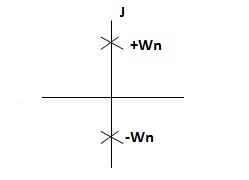
Sinwnt
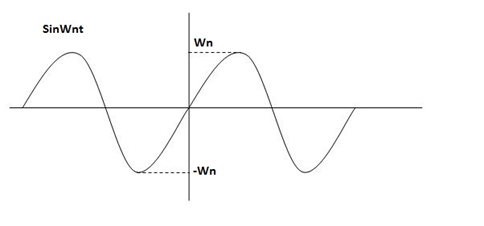
Fig 15 Undamped oscillations
As there in no damping i.e. oscillations at t= 0 are some at t  so, called
so, called
UNDAMPED
CONDITION 2: 0<<1
c(s) = R(s) wn2/s22 wn+wn2 R(t) =
wn+wn2 R(t) =  (t)
(t)
R(s) =1
C(s) = wn2/s2+2 wns+wn2
wns+wn2
CE
S2+2 wns +wn2 =0
wns +wn2 =0
S2, S1 = - wn ±jwn
wn ±jwn  1-
1- 2
2

C(t) = e- wnt sin( wn
wnt sin( wn  )t
)t
Wd=wn )
)
C(t)=e- wnt sin (wdt)
wnt sin (wdt)
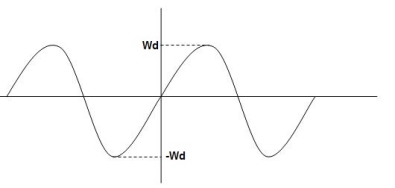
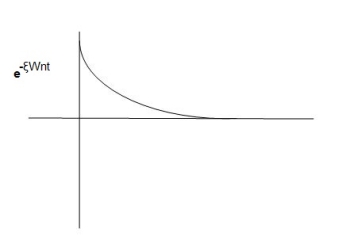
Fig 16 Underdamped oscillations
The oscillations are present but at t- infinity the Oscillations are 0 so, it is UNDERDAMPED
CONDITION 3 : =1
=1
C(s) = R(s) wn2/s2+2 wns+wn2
wns+wn2
C(s)=wn2/S2 +2wns+wn2
=wn2/(s +wn)2
CE S= -Wn
Diagram
C(t)= w2n /(
w2n /( )2
)2
C(t)=

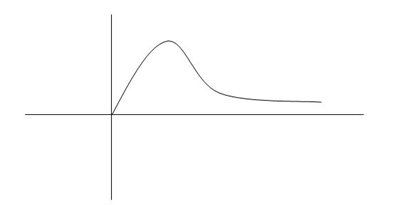
Fig 17 Critically damped oscillations
No damping obtained at  so is called CRITICALLY DAMPED.
so is called CRITICALLY DAMPED.
CONDITIONS 4 :- >1
>1
C(s) = wn2/s22 wnS+Wn2
wnS+Wn2
S1, s2 =  WN+-jwn
WN+-jwn
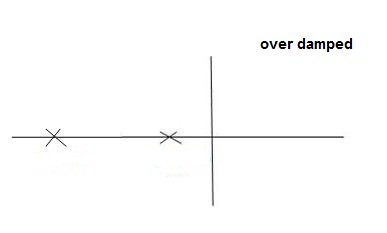
Fig 18 location of poles for over damped oscillations
a) UNIT Step Input:
R(s) = 1/s
C(s)/R(s) = wn2/s2+2 wns+wn2
wns+wn2
C(s) = R(s) wn2 /s2 +2 wns+wn2
wns+wn2
C(s) = R(s) wn2/s2+2 wns+wn2
wns+wn2
C(s) = R(s) wn2/s2+2 wns+wn2
wns+wn2
C(s) = wn2s(s2+2 wns+wn2)
wns+wn2)
C(t) = 1- e wnt/
wnt/ 1-es2 sin (wdt + ø)
1-es2 sin (wdt + ø)
Wd = wn 1-
1- 2
2
Ø= 
Where
Wd = Damping frequency of oscillations
Wn = natural frequency of oscillations
 wn = damping coefficient.
wn = damping coefficient.
T= Time constant
Condition 1 = 0
= 0
C(s) = wn2 /s(s2+wn2)
C(t) = 1- e° sin wdt +ø
C(t)= 1- sin( wn +90)
C(t) = 1+cos wnt
Constant

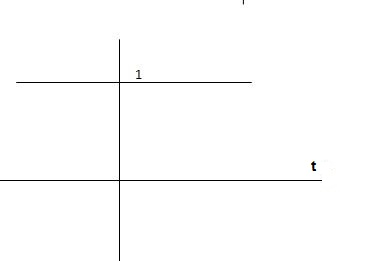
C(t) = 1+constant
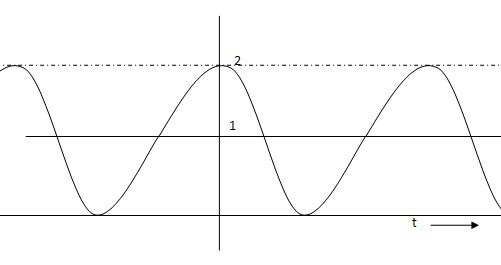
Fig 19 C(t) = 1+cos wnt
Condition 2:- 0< <1
<1
C(s) =  /s2+
/s2+ wns +wn2
wns +wn2
C(s) =1/s – s+ wn/s2+
wn/s2+ wns +wn2
wns +wn2
=1/s – s+ wn/(s+
wn/(s+ wn)2+wd2-
wn)2+wd2-  wn/(s+
wn/(s+ wn2) +wd2
wn2) +wd2
Wd = wn  1-
1- 2
2
Taking Laplace inverse of above equation
L --1 s+ wn/(s+
wn/(s+ wn) +wd2= e-
wn) +wd2= e- wnt cos wdt
wnt cos wdt
L-1 s+ wn/(s+
wn/(s+ wn)2+wd2 = e-
wn)2+wd2 = e- wnt sinWdt
wnt sinWdt
C(t) = 1-e- wnt [coswdt +
wnt [coswdt + /
/ 1-
1- 2 sinwdt]
2 sinwdt]
= 1-e wnt /
wnt / 1-
1- 2 sin [wdt +
2 sin [wdt +  1-
1- 2/
2/ ] t>=0
] t>=0
C(t) = 1-e wnt/
wnt/ 1-
1- 2 sin(wdt+ø)
2 sin(wdt+ø)
Ø =  1+
1+ 2/
2/
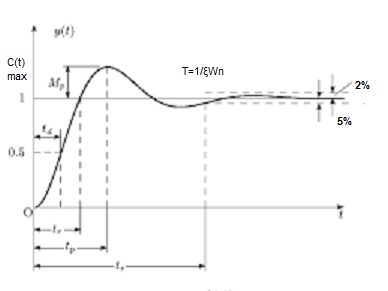
Fig 20. Transient Response of second order system
To find the time domain behaviour we consider a simple RLC circuit. When the poles and zeros of I(s) can be represented in terms of undamped natural frequency (wn)and damping ratio  . these can be represented as.
. these can be represented as.
Wn = 1/ Lc and
Lc and  =R/2
=R/2 C/L
C/L
For RLC network the characteristics equation of any second differential equation.
s2+2 wns+wn2=0
wns+wn2=0
s1s2=-2 wn+-
wn+- / 2
/ 2
=-2 wn+-
wn+- /2
/2
=-2 wn+-
wn+- /2
/2
=-2 wn+-2
wn+-2 / 2
/ 2
s1, s2 =- wn+-wn
wn+-wn
So, depending an § poles can be represented in various ways
a)  >1
>1
s1s2 = - wn+- wn
wn+- wn

Fig 11 Location of Poles and system response
As s1 s2 lies on negative real axis. This corresponds to OVERDAMPED are have exponential decay from in the time domain.
b) 0< <1
<1
s1s2 = - wn+-∫wn
wn+-∫wn 
The poles are plotted below having both real and imaging part
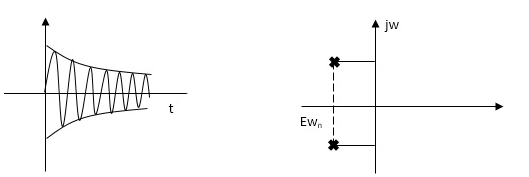
Fig 12 Time response Fig 13 Root Plot
As the roots have real and imaginary component as roots 0, this corresponds to UNDERDAMPED association. As initially oscillations exist, but oscillations seen as t-
c)  =0
=0
s1s2 = - wn+- wn
wn+- wn
s2+2 wns+w2n=0
wns+w2n=0
For  =0
=0
s2+wn2=0
s=Ijwn
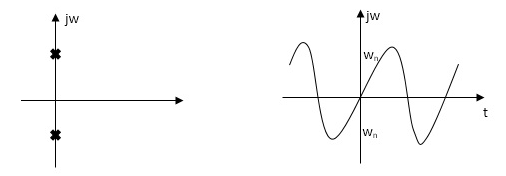
Fig 14 Root Plot Fig 15 Time response
As the complex conjugal the as at t=0 and t= same so, this is the case of UNDAMPED associations.
same so, this is the case of UNDAMPED associations.
Key takeaway
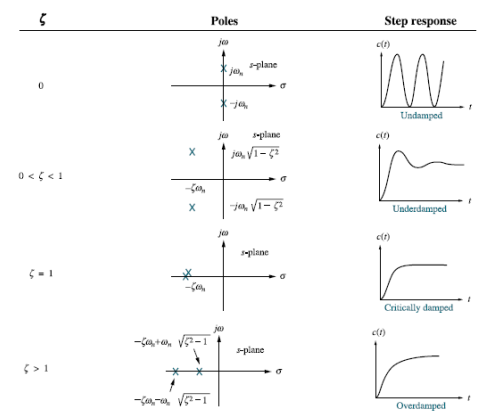
Q. For network below 1), pole - zero pattern is represented in fig 16), find numerical value of R, L and c for z (0) =1?

Fig 16 Pole zero plot
Solution
Calculating z(s) by taking L.T of fig 1)
z(s) = (R+SL)*1/CS
(R+SL)+1/CS = R+SL / SRC+S2LC+1
Z(S)= S+R/L / C [S2+R/L S+1/LC]
Given z(0)=1
z(0)=R/L / C/LC =1
Z(0)=R=1
.: R=1
Polls are given as
S2+RS/L+1/LC=0
S=-R/2L +J
Zeros are given as
S+R / L=0
From pole zero plot value of pole location is at -1 so
-R / L = -1
-1/ L=-1
L=1H
Also imaginary part of pole from plot is
 =
=
1/LC-(R/2L)2 =11/4
1/C-(1/2)2=11/4
1/C-1/4=11/4
1/C=11/4+1/4
1/C=12/4 =3
C=1/3 F
Hence, value of R=1 L=14 and c=1/3 f
L=14 and c=1/3 f
Q. FOR the following circuits, FIND G12(S) =v2/v1
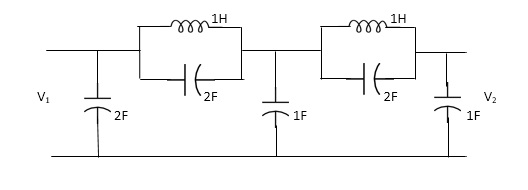
Solution Taking Laplace transform of above we have
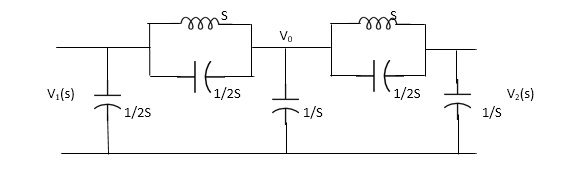
Fig 17 Laplace Transform of above circuit
Applying KCL at node v0
V0-V1(S) / S*1/2S/(S+1/2S) +V0+V2(S)/ (S*1/2S)/(S+1/2S)+V0/1/S=0
For Porr 2)We have,
v2-v0/(s*1/2s)/(s+1/2s)+v2/1/s =0 ---------(ii)
(v2-v0)(2s2+1) / s +sv2=0
v2 [2s2+1/s+s] = v0( 2s2+1)/ s
v0=v2(3s2+1) / (2s2+1)-----------(iii)
From (i) we have,
(v0-v1) /s (2s2+1) *sv0+(v0-v2)/5 (s2+1) =0
(2s2+1/5)v0-(2s2+1)/sv1+sv0+(2s2+1)/sv0-(s2+1)/s v2=0
(2s2+1)v1=(5s2+2)v0-(2s2+1)v2
Substitute value v0 from (iii) above
(2s2+1)v1 =[( 5s2+2)(3s2+1) /(2s2+1)-(2s2+1)]v2
(2s2+1)v1=(15s4+5s2+6s2+2-4s4+4s2) / (2s2+1 *v2
G12(s) = v2/v1 = (2s2+1) 2/11s4+15s2+1
Q) Find the transfer function admittance ratio
Y12(s) = I2(S) / V1(S)

Solution = Taking Laplace transform of above figure

Fig 18 Laplace Transform of above circuit
Applying KCL we get,
(V2-V1) / (3*1/2S) / (3+1/2S) * V2/ 1/2S+ V2/1/6 =0
(Y2-V1)(6S+1) / (6S+4) * (2S+6)V2V=0
BUT I2=-6V2
V2=-I2/6
We have ,
(6s+1) / (6s+4)*v2-(6s+1) / (6s+4)*v1 +(2s+6)v2=0
-[6s+1 / 6s+s+2s+6]I2 / 6 =V1(6S+1) / 6S+4
-[6S+1(2S+6)(6S+4)]I2= 6(6S+1)V1
-[(6S+1)*12S2+36S+8S+24] I2=6(6S+1)
I2 / V1 =-6(6S+1) / 12S2+50S+25
Y12(S) = I2(S) / V1(S) = -6(6S+1) / 12S2+50S+25
References:
- Engineering Circuit Analysis”, by W H Hayt, TMH Eighth Edition
- “Network analysis and synthesis”, by F F Kuo, John Weily and Sons, 2nd Edition.
- “Circuit Theory”, by S Salivahanan, Vikas Publishing House 1st Edition, 2014
- “Network analysis”, by M. E. Van Valkenburg, PHI, 2000
- “Networks and Systems”, by D. R. Choudhary, New Age International, 1999
- Electric Circuit”, Bell Oxford Publications, 7th Edition.